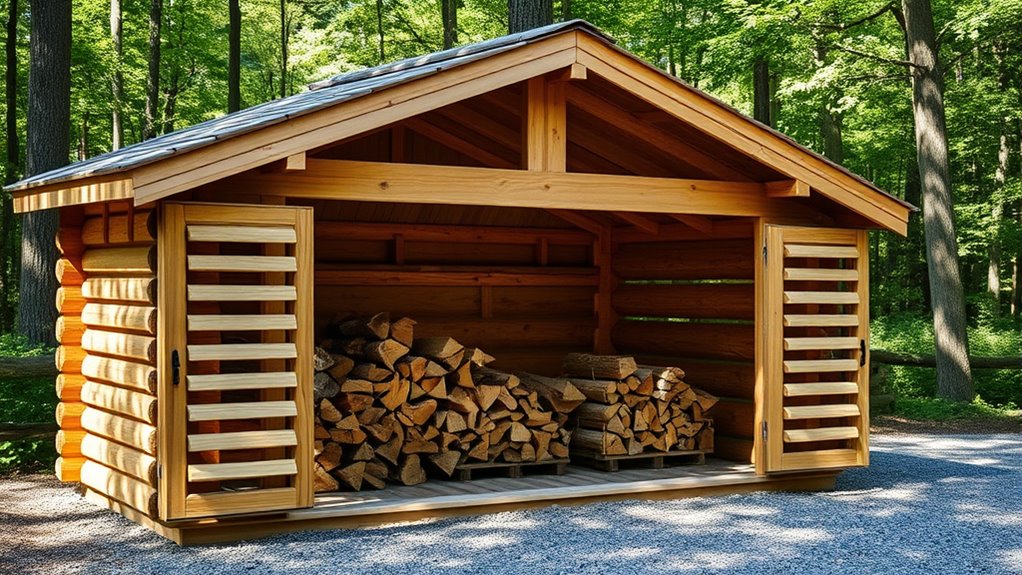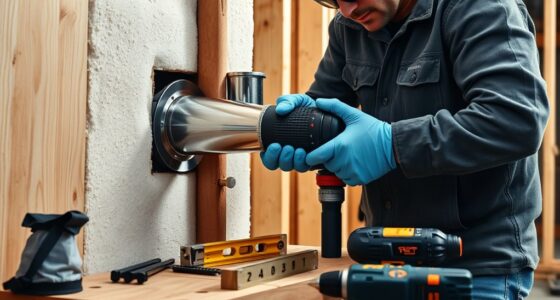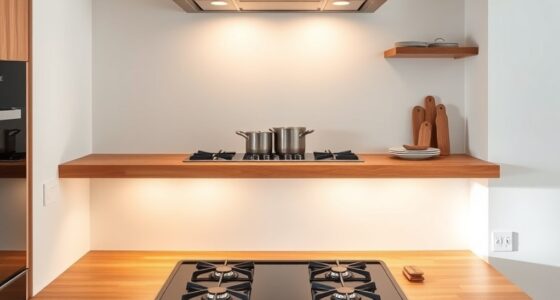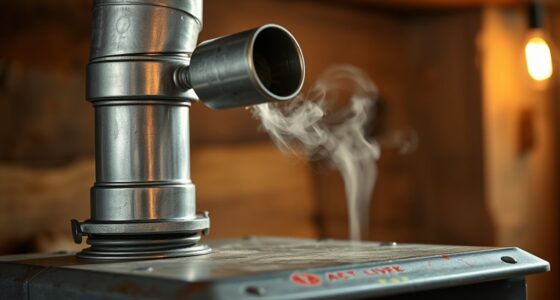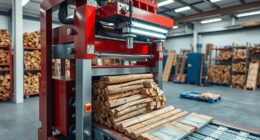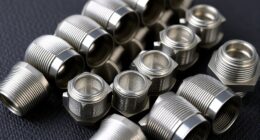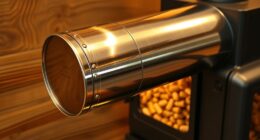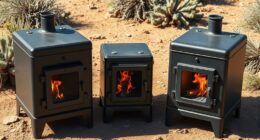To design a ventilated firewood shed, use durable, weather-resistant materials like metal or concrete, avoiding flammable options near the firewood. Incorporate adjustable vents or open sides to promote airflow, and add overhangs or a non-combustible roof to protect against rain. Proper ventilation prevents moisture buildup, keeping your firewood dry and safe. If you’re interested in building an efficient, safe shed, keep exploring for detailed tips and ideas.
Key Takeaways
- Incorporate adjustable vents or wall gaps to promote airflow and regulate humidity inside the shed.
- Use non-flammable, weather-resistant materials like metal or treated wood for safety and durability.
- Design open-sided or partially open structures to enhance natural ventilation and prevent moisture buildup.
- Include overhangs or roofing extensions to protect firewood from rain while maintaining airflow.
- Ensure proper placement away from ignition sources, with clear access and adequate space for wood stacking.

Have you ever wondered how to store firewood so it stays dry and burns efficiently? Proper storage isn’t just about keeping your wood off the ground; it’s also about guaranteeing it remains dry and accessible when you need it most. A well-designed, ventilated firewood shed plays a vital role in this. When planning your shed, fire safety should be your top priority. Proper ventilation helps prevent moisture buildup, which can lead to mold, decay, and even pests. Moist wood not only burns poorly but also creates dangerous creosote buildup in your chimney, increasing the risk of chimney fires. By designing a shed with good airflow, you reduce these risks and promote safer, more efficient fires.
Material selection is another critical aspect. When choosing materials for your firewood shed, think about durability, resistance to weather, and safety. Wood is a common choice for its affordability and ease of construction, but it needs to be treated or naturally resistant to rot and pests. Metal sheds are more durable and require less maintenance, but they can heat up excessively and pose safety concerns if not properly ventilated. Concrete or brick are excellent options for the foundation or walls because of their sturdiness and fire resistance, but they’re less flexible for customization. Whichever materials you choose, make sure they’re suitable for outdoor use and can withstand the elements.
A key to effective material selection is considering fire safety. For instance, avoid using flammable materials near the woodpile or inside the shed. Steel or concrete components can act as barriers to prevent accidental fires from spreading. Additionally, ensure that the shed’s roof is constructed from non-combustible materials and is designed with adequate overhangs to protect the wood from rain and snow. Proper material selection also involves choosing a design that encourages good airflow, such as open sides or adjustable vents, which helps keep the firewood dry and reduces humidity inside the shed. Good ventilation practices are essential for maintaining a safe and effective storage environment. Incorporating airflow management techniques, such as adjustable vents, further enhances this effect. Using weather-resistant materials can also extend the lifespan of your shed and reduce maintenance needs.
Incorporating ventilation features like adjustable vents or gaps in the walls allows air to circulate freely. This not only keeps the firewood dry but also helps in maintaining a safe environment by reducing excess moisture. When you focus on these factors—fire safety and material selection—you create a firewood shed that’s both functional and safe. The right combination of durable, non-flammable materials with thoughtful ventilation ensures your firewood stays dry, easily accessible, and ready for use when needed. Ultimately, a well-designed shed helps you enjoy your fires more safely and efficiently, preventing hazards and ensuring your wood remains in top condition. Additionally, proper ventilation techniques contribute significantly to reducing humidity and prolonging the lifespan of your firewood.
Frequently Asked Questions
What Materials Are Best for Firewood Shed Ventilation?
You should use materials like metal or perforated panels for firewood shed ventilation because they promote good air circulation. Wood slats or louvered panels also work well, allowing airflow while protecting the wood from rain. Avoid solid, non-porous materials that block air. Proper ventilation helps keep the wood dry and prevents mold, ensuring your wood storage stays in top condition. Prioritize materials that balance durability with effective air circulation.
How High Should the Shed Roof Be for Optimal Airflow?
You should aim for a roof height of at least 8 feet to maximize airflow efficiency. This height creates a natural chimney effect, encouraging warm, moist air to rise and escape, while fresh air flows in from below. Picture the shed like a tall, breathing tree, where the taller the roof, the better the circulation, keeping your firewood dry and well-ventilated for ideal storage.
Can I Build a Ventilated Shed on Uneven Terrain?
Yes, you can build a ventilated shed on uneven terrain. First, assess the soil drainage and foundation stability to prevent shifting or sinking. You might need to level the ground or construct a raised foundation to ensure stability and good airflow. Properly addressing soil drainage helps keep the shed dry and ventilated, protecting your firewood from moisture and rot while maintaining structural integrity on uneven ground.
What Are Common Mistakes to Avoid in Shed Ventilation Design?
Think of your shed’s ventilation as a delicate dance—miss a step, and airflow stalls. Avoid blocking intake and exhaust vents, especially roof vents, which are vital for drawing in fresh air and releasing moisture. Overlooking insulation or sealing gaps hampers efficiency, trapping dampness. Keep vents clear, make certain of proper placement, and don’t forget to maintain consistent airflow. Proper ventilation boosts efficiency and keeps your firewood dry and ready.
How Does Climate Affect Vent Placement and Size?
Climate considerations substantially influence vent placement and size in your shed. In humid or rainy areas, position vents higher to prevent water ingress and guarantee proper airflow, reducing moisture build-up. For colder climates, larger vents help prevent condensation and improve ventilation. Adjust vent size based on seasonal temperature changes, making certain of adequate airflow year-round. Proper placement and sizing optimize drying and storage conditions, protecting your firewood regardless of climate challenges.
Conclusion
Now that you’ve designed your ventilated firewood shed, you’re all set to keep your logs dry and ready for any medieval siege or modern camping trip. Remember, good ventilation prevents mold and rot, extending the life of your firewood. Just like an old-fashioned blacksmith relied on airflow to keep the forge hot, your shed’s ventilation guarantees your wood stays in top shape. With your plans in hand, you’re ready to build a cozy, efficient firewood fortress—no DeLorean needed!

